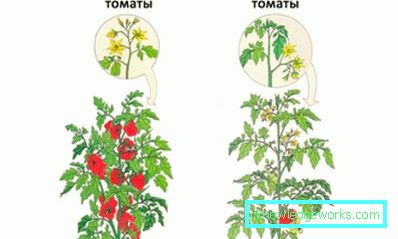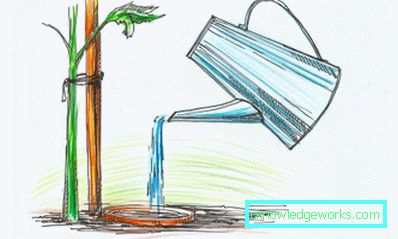Planting tomatoes in open ground
Planting tomatoes in open ground is the only option for gardeners who do not have greenhouses and greenhouses. In warm climates, tomatoes feel good without additional shelters, in cooler areas of planting should be covered with foil. In the open field, tomatoes are grown in a seedling way, this allows to shorten the growing season and get a harvest faster.

Planting tomato seedlings in open ground
Open ground: advantages and disadvantages
Growing tomatoes in the open field has certain advantages:
- tomatoes grow sturdier, highly immune;
- tomatoes do not tolerate excessive humidity, open space ensures a more favorable atmosphere;
- outdoor maintenance eliminates many dangerous diseases of the nightshade.
Among the disadvantages of open ground:
- Some valuable varieties of tomatoes can be grown only in the greenhouse, they die in open beds;
- it is more difficult to regulate the humidity and temperature of the soil;
- open field tomatoes grow more slowly;
- the latest ovaries do not have time to develop to frost;
- the yield of tomato in open beds is lower than in protected ground;
- fruits on the bushes do not reach the state of physiological ripeness, they have to be plucked green.

Varieties of tomatoes for open ground
Which varieties to choose
For cultivation in the beds fit specially bred, the most productive varieties and hybrids. They must be resistant to weather extremes: sudden frosts, drought, heat. Usually, early and middle-early tomatoes are planted in the open ground, later varieties do not have time to ripen to frost. Among the varieties and hybrids you can find a variety of options, they differ in color and shape of the fruit, pulp density, size. nuances of taste.
For open beds, low determinant bushes that do not need to be staved and formed are more suitable. Indeterminate plants, planted in unprotected soil, grow more compact, do not branch and do not stretch. Tomatoes in open ground need to be secured, and not only stalks should be tied up, but also branches with heavy fruits.

Determinant and indeterminate tomatoes
For open ground, the following varieties of tomatoes:

Scheme of planting tomatoes in open ground
Most varieties suitable for open ground, bred by Russian breeders. They are perfectly adapted for regions with a temperate or warmer climate, in cooler areas of the plant in the first days it is recommended to cover the film. The most productive varieties and hybrids need particularly careful care and abundant feeding.
To avoid unpleasant surprises, you need to choose seeds, on the bags which are clearly marked that they are suitable for open ground. It should be borne in mind that sowing seeds directly on the beds is not necessary, it is preferable to grow seedlings at home, moving it to the greenhouse, when all the seedlings will develop and get stronger.
How to grow strong seedlings for open beds
Growing tomatoes in the open field involves earlier sowing of seeds for seedlings. Sowing usually starts in late February or early March. Seeds should not be too old; seed yields 2-3 years old show the best yields. Before planting, the seeds are decontaminated in an aqueous solution of potassium permanganate or hydrogen peroxide, and then placed in a liquid growth stimulator for 12 hours. Saplings intended for open beds should be especially strong, you should not neglect preparatory manipulations.

Tomato seedling planting pattern
Soil preparation begins yes 10-14 days before sowing. Tomatoes prefer a light, nutritious soil on the basis of sand or black soil. It is advisable to use the soil in which the grown tomatoes will be planted. Before planting, it is carefully loosened, plant residues and other extraneous inclusions are selected. For disinfection the soil can be shed with an aqueous solution of copper sulphate or potassium permanganate. Such processing kills harmful microorganisms and insect larvae, tomatoes are less sick. Land for seedlings can be ignited in the oven or freeze. After processing it is mixed with an equal amount of humus, it is possible to add a small portion of sand.
The yield of tomatoes depends on the nutritional value of the soil. Humus, wood (preferably birch) ash must be added to it. It is possible to add fertilizers (for example, superphosphate or potassium sulfate). It is not worth making urea, it stimulates the abundant growth of tops to the detriment of fruiting.
Seeds are sown in deep containers with pallets or individual containers. Planting in small pots allows you to do without picking, which slows down the growth of seedlings and injures the root system. Tomatoes develop well with plastic or paper cups, peat pots, designs, independently rolled out of film.
Care for seedlings is easy. Immediately after sowing, containers are covered with foil and placed in heat. For successful germination, the seeds are buried 1.5-2 cm. After the emergence of seedlings, the seedlings are placed in bright light. It must be protected from drafts and direct sunlight. Water seedlings need warm soft water: separated, thawed or rain. To the soil is not washed away, it is convenient to use a spoon or spray. If necessary, a little more ground can be added to the cups.
After unfolding two true leaves, the tomatoes planted in a common container, dive into separate pots. If the seeds have been sown in individual containers, picking is excluded. The transplanted seedlings are fed with an aqueous solution of a complete complex fertilizer. The second feeding is carried out before moving the seedlings to the beds. This preparation makes the seedlings strong and strong, perfectly stimulates their immunity.

Hardening tomato seedlings before planting
2 weeks before transplanting the seedlings begin to harden. They are taken out to the balcony or veranda, first for an hour, then for two. Gradually walks are extended, in good weather, tomatoes spend on the street all day. Hardening prepares tomatoes for life in the open field, plants do not stretch, grow stronger, the green becomes bright.
Planting low-growing tomatoes in open ground (video)
Transplant into the ground: a sequence of actions
For the successful cultivation of tomatoes, it is important to choose the right plot. Tomatoes like bright, but diffused light, in a dense shadow their growth stops. It is important that water does not stagnate in the ground; this can lead to unpleasant consequences: blackleg, root, apical or gray rot. On the beds for growing tomatoes, you can sow green manure, enriching the soil with nutrients. Their role is played by lupine, legumes, mustard or alfalfa. It is not necessary to plant tomatoes on plots that were previously occupied by eggplants, potatoes or other members of the nightshade family.
Planting tomatoes in open ground begins when the soil is fully warmed. Its temperature should not fall below 15 degrees, night frosts are undesirable. Typically, the temperature of the soil reaches closer to the end of May. It is possible to accelerate the heating of the soil, pre-setting the beds for tomatoes with two layers of dense polyethylene film. It not only contributes to the rapid heating of the soil, but also prevents the multiplication of weeds.

Selection of tomato seeds
A week before planting, the soil must be loosened thoroughly, clearing it of plant residues. Then add humus or peat to the ground, perekapy to the depth of the bayonet spade and cover again with film. Under polyethylene, the soil will retain the desired level of moisture, and the tomatoes after transplantation will start growing faster. Planting tomatoes in the ground is carried out in warm, but not too hot weather, preferably in the morning. After planting, the film from the beds should be removed, the soil should be dug up again.
Ready for planting tomatoes must be strong, not overgrown. It is desirable to have at least one flower brush and 6-7 strong leaves. It is important to ensure that seedlings are not sick and are not affected by pests. Found aphids or thrips need to withdraw before transplanting, treated seedlings with soapy water or insecticides.
Planting is carried out according to the scheme, which depends on the height and spreading of the bushes. Between extremely tall plants there is a space of at least 60 cm, more compact bushes can be planted after 40-45 cm. Planting rules also depend on the characteristics of the variety. You can plant tomatoes in open ground trench method, leaving the aisle about 70 cm
Some varieties prefer planting in the hole. The distance between them should not be less than 40 cm; superphosphate or birch ash should be pre-expanded in each well. You can understand how to plant seedlings from detailed master classes of experienced gardeners. Beginners need to act carefully, relying on intuition and common sense.

Tying tomatoes to pegs and watering tomato seedlings with warm water
Before planting seedlings need to inspect. At overgrown tomatoes, 2-3 bottom leaves are removed, this allows the seedlings to be slightly buried, not allowing it to stretch. Seedlings are moved into the hole along with an earthy clod, overgrown roots can be gently pinch. The roots should not bend, they must be placed freely. Tomatoes in peat pots are placed in the hole with the tank, the peat walls must be pre-cut in order not to restrict the growth of the roots.
Tomatoes after planting need to pour warm water. The hole is filled with earth, the surface is rammed by hands. On top of the soil sprinkled with a thin layer of peat. After peat mulching it is not necessary to water the planting, otherwise a crust forms on the soil, preventing normal air exchange. Particularly thermophilic varieties can be covered with a film for 1-2 days.
Immediately after planting, the stalks of tomatoes are lifted and tied to pegs, previously dug in near each hole. If you dig in the stakes later, they can damage the roots. Another mounting option is tying to the trellis. This option is especially good for tall indeterminantnyh varieties. To tie up tomatoes you need soft shreds or a special adhesive tape, suitable plastic clips. Wire or fishing line can not be used, hard material can cut the delicate tomato stalks.
To understand how to plant tomatoes, you can after watching thematic training video.
Such mini-films are ideal for beginner gardeners, they detail the sequence of actions, allowing you to avoid most of the common mistakes. Usually in the video they tell you how to plant tomatoes correctly, explain the intricacies of preparing open ground, the technology of growing tomatoes by varieties, the characteristics of watering and feeding. Video tutorials provide answers to all the typical questions of novice gardeners.
Planting tomato seedlings (video)
Rules for the care of tomatoes in the garden
Caring for tomatoes in the open field is no different from growing tomatoes in greenhouses. The technology of growing tomatoes is almost the same. The only exception is that tomatoes do not need airing. With a cold landing planting can be covered with a film, but this technique is necessary only in areas of risky farming or when planting very naughty varieties.
Growing tomatoes in the open field, you need to be prepared for weather extremes. Care in open ground includes the proper watering, feeding, timely removal of weeds. To rid yourself of the need to constantly destroy weeds, the soil under the tomatoes can be mulched peat, sawdust, husks of sunflower seeds.
Agricultural cultivation of tomatoes depends on the variety. Before planting tomatoes, it is important to get acquainted with the peculiarities of a particular variety, detailed descriptions are on each sachet of seeds. You can watch thematic videos about the care of a particular brand. Experienced gardeners willingly publish the secrets of agrotechnology in specialized journals, post them in their own blocks, give recommendations at specialized fairs.

Watering tomatoes with a solution of potassium permanganate for disinfection and prevention
Tomatoes in open ground need timely, but not excessive irrigation. It is important to monitor rainfall, natural moisture is usually not enough. Only warm water is used for irrigation; cold water causes shock to plants; bushes can shed ovaries. After transplanting tomatoes into the soil, after 10 days they are watered with a weak solution of potassium permanganate to prevent rot, viruses and late blight.
The yield of tomatoes depends on the nutritional value of the soil. The first feeding is carried out 2 weeks after landing in the ground. It is better to use a full complex fertilizer with a high content of phosphorus and potassium. Suitable superphosphate or potassium sulfate, preferably in the form of an aqueous solution. After fertilization, tomatoes must be watered abundantly, washing away the nutrient solution from the stems and leaves. This will help avoid burns and speed up the absorption of fertilizer into the soil.
Industrial insecticides help against insect pests. They perfectly destroy thrips, spider mite, whitefly. From aphids saves washing the stems and leaves with warm soapy water. Bare slugs are harvested by hand; spraying the landings with a solution of ammonia will help prevent their occurrence.
In the open field, tomatoes are sick much less often. In case of late blight epidemics, the bushes are sprayed with copper-containing preparations, you can buy them ready-made or make them yourself by mixing warm soapy water with a small amount of copper sulfate.

Damage of tomatoes by phytophthora
Problems with transplantation
Understanding how to plant tomatoes in open ground is easy. But even a perfect transplant does not guarantee instant survival. Plants can wither and turn yellow, they slow down the growth or stop flowering. You should not get upset, adaptation of saplings can be accelerated.
It is important to ensure that plants receive enough sunlight. Seedlings grown in individual pots, take root faster and immediately start to grow. Very frail saplings can be fed with nitrogen-containing fertilizers, increasing the growth of green mass.

Application of Fitosporin for survival of tomato seedlings
For better survival, young tomatoes are recommended to be sprayed with a weak solution of potassium permanganate or a special non-toxic phyto-preparation. The ideal option is Fitosporin, which strengthens the protective forces of plants and stimulates their growth. The advice of experienced gardeners and agrotechnists will help to learn how to grow healthy and strong tomatoes.
Opinion gardeners
Usually, gardeners are unanimous in their feedback on this method of growing tomatoes. Their reviews agree that the cultivation of tomatoes in the open field requires great attention and careful selection of varieties. Many amateurs recommend planting a part of the bushes in a greenhouse, while others are placed in open beds. Such an approach will help extend the fruiting period, in case of adverse weather conditions there is no risk of losing a crop.
Much depends on the climatic conditions. In warm regions, even varieties intended for cultivation under film are planted in the ground, but in areas with cold and short summers it is better not to risk it. Breeders offer a sufficient number of productive varieties suitable for open ground. At the same time, gardeners note that the fruits do not always fully correspond to the image in the photo, this should be prepared in advance.
In the open ground, it is more difficult to protect plants from pests: aphids, naked slugs, thrips, Colorado beetles. But tomatoes are less likely to suffer from late blight and viral diseases, in general, they are stronger and more durable. The size and weight of the fruits of the place of cultivation does not affect, much more important than the correct and timely pasynkovanie bushes. Confirmation of the words of amateur gardeners can be found in numerous video presentations and photos showing a great harvest.
Planting tomatoes in open ground (video)
Choosing how to plant tomatoes, so that the crop was maximum, you should not limit yourself to thinking about greenhouse designs. Tomatoes grow well and ripen in the open field. It is not necessary to wait for them to turn red on the bush. Fruits can be picked in a state of technical ripeness, they ripen successfully at room temperature. Experienced gardeners will be happy to share ideas on how to grow tomatoes, their advice should not be ignored.